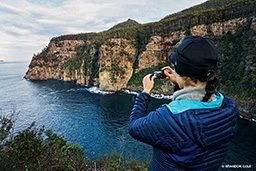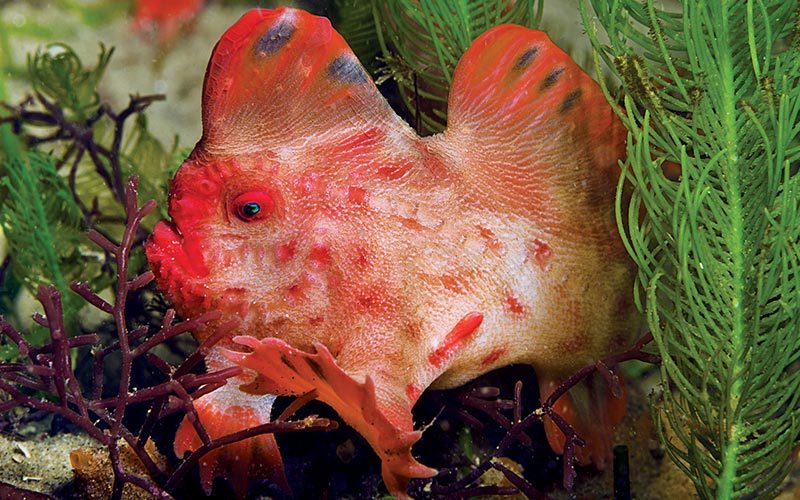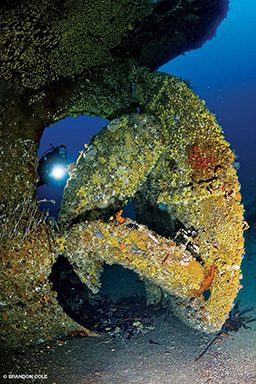
We might as well be on Mars for all the good my marine biology training is doing me right now. What’s that spiky fish in the convict suit? With severe angles, knifelike fins and a protruding Pinocchio nose, it resembles a cross between an alien fighting machine and a cartoon character. Genus and species of the cloud of pink fish? No clue. Pouring down from above in the hundreds, they must be the rain that nourishes this thriving garden of sponges in Crayola-bright colors. And what’s the blue-chinned, thick-lipped piscine oddity that slips furtively among 3-foot-high, peach-hued candy-cane-shaped things? It’s a scene straight out of a Dr. Seuss story. I don’t recognize any of the players on the stage, and my ignorance is bliss. Who wants to travel 9,000 miles to see the same old things?
Tasmania is a place “like nowhere else on Earth,” the brochures claim. It’s a lofty boast, but from where I swim, awash in the weird and wonderful 125 feet below the surface of the Tasman Sea, I must agree.
Off the Radar

The goal was to broaden our dive horizons by jumping off the beaten path. In Tasmania we were destined to succeed big time. Tucked beneath the bulk of mainland Australia, this island serves up some of the world’s best temperate-water diving.

The seed of inspiration for a trek to Tassie was planted 20 years ago by photos I saw in National Geographic — pictures of strange creatures, shadowy kelp forests and invertebrate-plastered rocky reefs under a heaving ocean and towering sea cliffs. It took a while to reach these distant shores, but we’re finally here, down under the land down under. Irrefutable proof of our location are the road signs we passed on yesterday’s drive from Hobart, the capital, to Eaglehawk Neck, warning of crossing Tasmanian devils. Further corroboration is the tiny red handfish now posing in front of my camera. It’s one of the world’s rarest fish; the Australian Department of the Environment estimates that fewer than 1,000 exist in the wild, and they’re all in Tasmania. It’s a real beauty, even if it appears to have a bad case of measles. But it seems happy enough as it walks stiffly along the bottom on scarlet-fingered fins.
It took Mick Baron’s eagle eyes to find the cryptic beast hiding among a surge-tossed tangle of algae 15 feet deep in Frederick Henry Bay. Baron gives me a good-natured ribbing while we’re celebrating after the dive. “Sneaky little buggers,” he said. “Reckon you’d have found it on your own?”
“Not in a hundred years,” I answer unequivocally.
“That’s about average,” Baron continues. “Takes a while to figure them out. You’re off to a good start having seen a handfish already.” With a combined 75 years of diving between them, Baron and his business partner, Karen Gowlett-Holmes, know a thing or two about this unique corner of the underwater world.
Touring the Tasman Peninsula
From our base in Pirates Bay we head south along a remarkably rugged coastline into Munro Bight to dive the wreck of the SS Nord. One of Tassie’s signature dives, this 290-foot cargo steamship sank in 1915 during a brutal storm. We’re smack dab in the middle of the “roaring forties,” where gale-force westerly winds and punishing waves have a long history of wreaking havoc on vessels plying these extreme southern latitudes. But today’s June weather is lovely — 60°F under the bluest of skies with just a gentle breeze — and my wife, Melissa, and I thoroughly enjoy surveying this sleeping giant from a past age. It rests upright on a sandy bottom at 130 feet. Our 28 percent nitrox is put to good use, extending our bottom time at the stern. The Nord‘s enormous rudder and propeller are the prime photo attractions, glowing a soft yellowy orange in the blue-green gloom thanks to a patina of encrusting zoanthid anemones and sponges.

We descend on the resplendent Deep Glen Bay North Wall, a colorful tapestry of fish and invertebrate life. Drawing on Gowlett-Holmes’ encyclopedic knowledge I’m able to put names to the faces of Shaw’s cowfish, banded morwongs and gorgeous “crays” (rock lobsters), which I find crammed into a crevice. She saves the day when I return from a shallow dive on kelp-wreathed Fok Rock with photos of more mystery critters that she quickly identifies as ocellate sea stars, a Maori octopus, and Pseudopallene ambigua — canary-yellow creepy-crawlies also known as a pycnogonid sea spiders. In picturesque Waterfall Bay we explore Cathedral Cave, swimming in through the “eyes” of the skull cave portion of this extensive sea cave system, the largest in Australia. While Melissa and I traverse interconnected tunnels and chambers at around 50 feet, we hear powerful wuuummphing sounds around us every 15 seconds; it’s the waves smashing into the cliff walls outside. It sounds like a giant heartbeat, rhythmic, incessant and more than a little bit eerie.
With a weather forecast calling for another nice day before winds and swell begin to build, we plan visits to two of the more exposed sites. Because of the depth as well as surge and strong currents that Baron says are impossible to predict, Sisters and Thumbs are both advanced dives. Here we plummet through darkness to stunning sponge gardens that bloom brightly at around 130 feet. We come back up with eyes wide in wonder — and a new list of species we’ve never seen before.
Twilight of the Kelp Kingdom
As we drop anchor near a floating mat of golden kelp fronds in Fortescue Bay, I proudly exclaim to all, “Giant kelp, Macrocystis pyrifera!” I am redeemed, finally having recognized something in Tasmania’s marine ecosystem.

Minutes later I’m swaying in the surge 40 feet beneath the canopy, gazing up at the magnificent algae I know so well. I’m smiling but confused. What’s that fish over there? And that sponge to my left? Though the neighborhood’s architecture is familiar (this is indeed the very same kelp species that flourishes on the other side of the Pacific in my old stomping grounds, California), its residents are unknown to me. Luckily, Baron anticipated this and jumped in with us this time. He whips out a slate and starts my education, first pointing at something and then writing down its name as we tootle about the forest: Johnston’s weedfish, banded stingaree, a cute little Australian swellshark, a ginormous 5-foot-wide ray, a short-tail stingray, and my convict-striped bizarro — the longsnout boarfish. My head threatens to explode from this influx of arcane fish lore. After 50 minutes we’ve covered both sides of the slate. During our safety stop he directs my attention to a school of bronzy fish swimming underneath us. He squeezes in one more name and hands me the slate: bastard trumpeter. I burst out laughing.
Back on board, I seek confirmation on the last sighting. Baron affirms, “Sure enough, bastard trumpeters. We also have real bastard trumpeters. Different species.” I start laughing all over again. Australians have a way with the English language, and their panache is quite charming. But my good humor ebbs when I learn about Tasmania’s disappearing kelp forests.

Giant kelp used to thrive all along Tassie’s east coast. Scientists say that 90-95 percent of the forests are now gone, the amazing algae a victim of warming oceans. Wintertime temperatures used to average 50°F; today we measured 57°F. The southward-flowing tropical East Australian Current (the underwater highway Nemo rode to Hollywood fame), which historically veered east when it passed Sydney, is now pushing farther south, warming Tasmanian waters. This spike in temperature has caused sea urchin populations to boom, and they’re feeding on kelp nonstop, year-round. The forests are being clear-cut. The last holdfasts for Macrocystis pyrifera along the Tasman Peninsula are in Fortescue Bay and Munro Bight. With no guarantee they will still be here in 10 or 20 years, the time for kelp fans to dive Eaglehawk Neck is now.

It’s nearly time for phase two of our expedition, but before we depart the peninsula for the northern reefs of Bicheno we dedicate a day to enjoying topside scenery. We begin with a prebreakfast clifftop hike around Waterfall Bay for a spectacular bird’s-eye view of some of our dive sites. Farther south, Cape Hauy’s iconic sea-stack rock formations — the Candlestick, Totem Pole and the Lanterns — beckon alluringly in the mauve-tinged dawn. We answer their call, taking a high-speed Zodiac cruise. Highlights include bow-riding dolphins, sightings of seals and albatrosses and staring up slack-jawed at imposing Cape Pillar. This impossibly sheer precipice of columnar dolerite rises 1,000 feet straight up from the churning sea.
“Speccy” Dives in Bicheno
A three-hour drive north takes us to Bicheno, a cool seaside town cradled in an idyllic bay. The soaring sea cliffs and craggy forested slopes of the south have been replaced by gently rolling hills and a beach of red lichen-covered rock slabs sliding into the sea. This is Tasmania’s other famed scuba hub. Just a stone’s throw offshore, Governor Island Marine Reserve contains most of the area’s top spots, which include deep pinnacles (“bommies” in Aussie-speak), luxuriant sponge gardens and interesting reefs formed by building-sized granite boulders.
Without delay we head for the water, climbing onto Iruka, a sturdy, custom-built Devil Cat boat with a splendid Shaw’s cowfish painted on its hull. (I learned something in my Tassie marine biology 101 course at Eaglehawk.) Bruce Priestley greets us warmly. He’s a giant of a man, reminiscent of Cape Pillar, and he crushes my hand with a smile. “Welcome. Ready to go? We’ll be at Toblerone shortly.”

Fast forward five minutes and we’re dropping through the blue, 120 feet straight down. Outcroppings shaped like pyramids rise from a flat sandy plain. Each is an oasis of life, a riot of garishly colored invertebrates over which a variety of fish swarm — wrasses, filefish and even a family of boarfish awkwardly parade back and forth under a bristling hedge of brilliant finger sponges.
The Canyon has great “bottomography” — a mix of miniwalls, rock piles, alleyways and underhangs with no substrate left uncolonized. Life is stacked upon life. On Trap Reef we are mobbed by a dense school of pink butterfly perch. A pile of monolithic boulders at Bird Rock creates swim-throughs with walls carpeted in countless jeweled anemones. A cavelike chamber called the Ballroom has a ceiling plastered with them, too. Bullseye sweeper fish lurk in the shadows above plate-sized abalone. A massive cray creeps from a crevice, antennae twitching in irritation at our intrusion.
I put in a special request for Golden Bommies, a must-do according to a local photographer. Sucking 29 percent nitrox for what Priestley hinted was another squarish, deepish profile, we freefall through open water to 90 feet when, sure enough, two golden bommies heave into view. Their domes are smothered in yellow zoanthid anemones and are positively hairy with sea whips. A vision of harvest-ready wheat kissed by warm sunlight comes to mind. Entranced, we sink deeper along a wall decorated with fiery finger sponges. To my nitrogen-loaded brain they appear as bloody, grasping hands, or perhaps they are the writhing fingers of orange-red flames hungrily licking upward from the reef. My capacity for imagination certainly seems to grow with depth. We touch down at 125 feet and pause to take it all in. Such a pity we can’t do our deco down here.
Upon reluctant return to the surface world, Priestley grins at us and asks drily, “Worth the effort?”
“Absolutely. Absolutely amazing,” Melissa answers.
Casually, our captain agrees, “It’s a really speccy dive.” Though the colloquial tongue is sometimes a bit hard to follow, this time we need no translation: It was really spectacular indeed.
Here Be Penguins (and Dragons)
The blue fairy penguins waddling across the road are yet another reminder we’re not in Kansas anymore. We stop the car and hang out of the window, managing a quick photo before they scramble into the underbrush. Just another night on the town in Bicheno. The little guys have just returned from dinner at sea, where we happen to be headed for a night dive.

Everyone knows about the Tasmanian devil, this island’s signature marsupial that resembles a vicious hyena-rat hybrid. But less well known are the island’s penguins — and dragons. No joke, dragons fly through the Tasman Sea. We’ve already done three superb, shallow shore dives in Waub’s Bay this week for seadragons while offgassing between deeper dives. And we’ve signed up for one more, this time by moonlight.
We start in just 10 feet and swim steadily deeper, navigating easily by keeping the algae-festooned rocks to our right and the sand to our left. Banded stingarees, those dime-a-dozen photogenic stingrays, flutter through our light beams. There are nudibranchs and crabs, scorpionfish and cuttlefish. We’ve really found our groove by the time we hit 30 feet, spying critters one after another. I point out a swellshark resting on its kelp blanket and then a big-belly seahorse hanging upside down. I capture a nice portrait of a sleepy Shaw’s cowfish. Males are striking photo subjects with their Maori tattoo-inspired neon patterns.

My wife outdoes me handily when she parts a curtain of kelp fronds to reveal a weedy seadragon. So improbable in appearance it must be magical, this creature is an Australian aboriginal painting of some fantastical beast come to life. Its psychedelic coloration is indescribable. Its body shape defies logic. It is so exceedingly strange it can’t possibly exist. We find three more by the time we emerge exhausted but victorious 80 minutes later. Melissa sums things up eloquently: “I’d travel all the way to Tasmania just for the dragons. They really are the weirdest things I’ve ever seen.”
As our plane hurtles into the sky to take us up and far away, I can’t help but press my face to the window. I gaze longingly down at this most singular island. I squeeze my eyes shut, willing myself to sear every detail of this extraordinary experience into indelible memory.
Some say that from the air, Tassie resembles the footprint of a beast or a shark’s tooth. Maybe. But I know with certainty that from below, beneath the waves, it looks like nowhere else on Earth.
How To Dive It

Conditions
Depths range from 10 to 140 feet, and currents range from mild to wild depending on the site and Poseidon’s whim, so pay attention to briefings, and dive within your limits. Required skill level is intermediate to advanced. Water temperatures average 55°F to 65°F year-round, so a drysuit or full 7 mm wetsuit is recommended. Visibility ranges from 30 feet to more than 100 feet, with the best clarity in winter (June through September). There is a hyperbaric chamber at the Royal Hobart Hospital.
Getting There
Fly into Hobart (HBA), rent a car, and drive to Eaglehawk (approximately one hour) or Bicheno (approximately three hours).
Topside Activities
On the Tasman Peninsula:
- Hike the Cape Hauy track for breathtaking views of the Candlestick and Totem Pole sea stacks.
- Take an ecocruise between Eaglehawk Neck and Port Arthur to see majestic sea cliffs and abundant wildlife such as albatrosses, seals and dolphins.
- Stroll back through time at the Port Arthur historic site, a former timber station and penal colony.
- Come face to face with everyone’s favorite carnivorous marsupial at the Tasmanian Devil Conservation Park, and see other native wildlife including quolls, wombats, pademelons and more.
In the Bicheno area:
- Take a nighttime tour to see wild blue fairy penguins.
- Feast on killer, creative pizzas and local, organic fare at Pasini’s Café.
- Paddle a sea kayak for a day (or longer) in the Bay of Fires Conservation Area.
- Explore picturesque Freycinet National Park, where you can picnic on a perfect beach in Wineglass Bay, photograph the pink granite peaks of the Hazards Range and trek for days.
Explore More
Watch Tasmania’s iconic red handfish walk on the ocean floor.